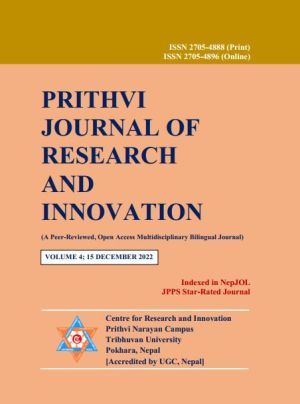वर्तमान माध्यमिक तहको नेपाली भाषा पाठ्यक्रममा कक्षागत (कक्षा ९ र १०) तुलना [A Grade-Wise (Grade 9 and 10) Comparison of the Current Secondary Leval Nepali Language Curriculum]
DOI:
https://doi.org/10.3126/pjri.v4i1.50167Keywords:
भाषा पाठ्यक्रम, सहजीकरण प्रक्रिया, मूल्याङ्कन, प्रकार्यपरक ढाँचा, Language curriculum, facilitation process, evaluation, productive, functional structureAbstract
प्रस्तुत लेख वर्तमान नेपाली भाषा पाठ्यक्रम (कक्षा ९ र १०) को कक्षागत तुलना गर्ने मूल उद्देश्यमा आधारित रहेको छ । उत्पादनमुखी पाठ्यक्रमको प्रकार्यपरक (Functional) ढाँचालाई सैद्धान्तिक आधार बनाइएको प्रस्तुत अध्ययन गुणात्मक ढाँचामा आधारित रहेको छ । प्राथमिक सामग्रीका रूपमा माध्यमिक शिक्षा पाठ्यक्रम (२०७१, भाग १) प्रयोग गरिएको प्रस्तुत अध्ययनमा शीर्षकसम्बद्ध अङ्ग्रेजी र नेपाली भाषाका अनुसन्धानात्मक सामग्रीहरू पनि उपयोग गरिएको छ । यसअनुसार निर्दिष्ट नेपाली भाषा पाठ्यक्रमको परिचय, तहगत सक्षमता, सिकाइ सहजीकरण प्रक्रिया र विद्यार्थी मूल्याङ्कन प्रक्रियामा कक्षा ९ र १० बिच रहेको समानता तथा कक्षागत सिकाइ उपलब्धि एवं विधाको क्षेत्र तथा क्रम र विस्तृतीकरणअन्तर्गत विद्यमान तुलनीय प्रकार्यपरक भिन्नतामा अनुसन्धान आधारित गरिएको छ । विधाको क्षेत्र तथा क्रम र विस्तृतीकरणअन्तर्गत कक्षा नौका लागि कथाअन्तर्गत लोककथा र ऐतिहासिक कथा, रुपकअन्तर्गत संवाद र वक्तृता तथा चिठीअन्तर्गत घरायसी निवेदन ÷कार्यालयीय र दैनन्दिनका कार्यकलापमा आधारित दैनिकीलाई एवं कक्षा १० का लागि कथाअन्तर्गत पौराणिक, निबन्धअन्तर्गत सांस्कृतिक, रुपकअन्तर्गत एकाङ्की, वादविवाद र मनोवाद एवं चिठीअन्तर्गत व्यापारिकलाई भिन्न पाठ्यवस्तुका रूपमा छनोट गरी तिनमा आधारित प्रकार्यपरक पाठ्यवस्तुको प्रस्तुतीक्रम उल्लेख गरिएको देखिन्छ । कक्षागत सिकाइ उपलब्धिअन्तर्गत कक्षा नौमा सुनाइ र बोलाइलाई तथा कक्षा १० मा पढाइ र लेखाइलाई बढी जोड दिनुपर्ने, सुनाइ र बोलाइ बोध र अभिव्यक्तिका आधारभूत सिप भएकाले यिनको मूल्याङ्कनतर्फ २५ अङ्क अपर्याप्त रहेकाले ४० अङ्क बनाउनुपर्ने अध्ययनको निष्कर्ष रहेको छ ।
[The paper aims to make a grade-wise comparison of the current Nepali language curriculum with reference to Grade 9 and 10 of secondary level. The study has adopted a qualitative research method based on functional structure of the productive curriculum. Using the secondary school curriculum (2071 BS, Part 1) as a primary source of information, the study has collected the data from research materials that are related to this topic. In doing so, the study is based on the differences in the functional structure of Grade 9 and 10 of secondary level curriculum in terms of its similarity, grade-wise learning and scope, order and details, especially focusing on the background, grade-wise competence, learning facilitation process and student evaluation method of the prescribed Nepali language curriculum. For Grade 9, folk tales and ancient tales for stories, dialogues and speeches for conversation, and formal or informal applications and everyday conversations have been selected for the scope, order and details of the curriculum; for Grade 10, ancient tales for stories, cultures for essays, one-act plays, dialogues and monologues for conversation and business for letters have been categorically selected for their presentation of functional materials. To meet the objectives of this study, it is recommended that emphasis should be given to listening and speaking for Grade 9, and reading and writing for Grade 10. Since the understanding and expression are the basic skills for listening and speaking activities, the evaluation weightage of 25 marks is insufficient; thus, the evaluation weightage should be 40 marks.]
Downloads
Downloads
Published
How to Cite
Issue
Section
License
Copyright (c) 2022 Centre for Research and Innovation (CRI), Prithvi Narayan Campus (TU)

This work is licensed under a Creative Commons Attribution-NonCommercial 4.0 International License.
© Centre for Research and Innovation (CRI), Prithvi Narayan Campus (TU)

